Cash_and_Liquidity_Management 现金和流动性管理
- 格式:pps
- 大小:416.56 KB
- 文档页数:13
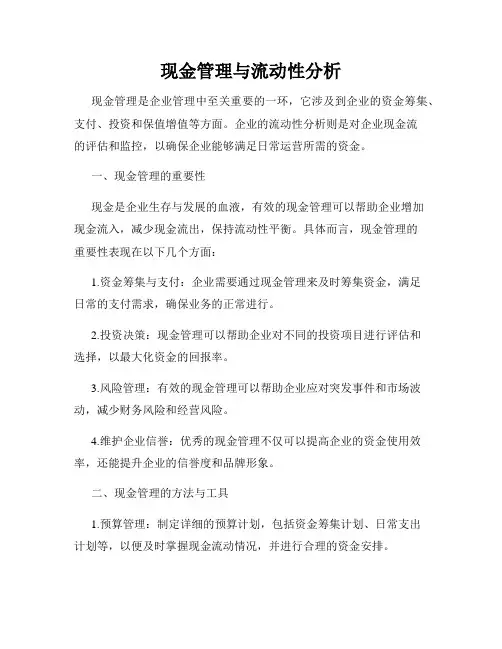
现金管理与流动性分析现金管理是企业管理中至关重要的一环,它涉及到企业的资金筹集、支付、投资和保值增值等方面。
企业的流动性分析则是对企业现金流的评估和监控,以确保企业能够满足日常运营所需的资金。
一、现金管理的重要性现金是企业生存与发展的血液,有效的现金管理可以帮助企业增加现金流入,减少现金流出,保持流动性平衡。
具体而言,现金管理的重要性表现在以下几个方面:1.资金筹集与支付:企业需要通过现金管理来及时筹集资金,满足日常的支付需求,确保业务的正常进行。
2.投资决策:现金管理可以帮助企业对不同的投资项目进行评估和选择,以最大化资金的回报率。
3.风险管理:有效的现金管理可以帮助企业应对突发事件和市场波动,减少财务风险和经营风险。
4.维护企业信誉:优秀的现金管理不仅可以提高企业的资金使用效率,还能提升企业的信誉度和品牌形象。
二、现金管理的方法与工具1.预算管理:制定详细的预算计划,包括资金筹集计划、日常支出计划等,以便及时掌握现金流动情况,并进行合理的资金安排。
2.现金流量表:通过制定现金流量表,可以清晰地了解企业的现金流动情况,及时发现问题并采取措施解决。
3.库存管理:合理的库存管理可以减少资金占用,提高现金的周转率,降低流动性风险。
4.账期管理:合理控制付款期限和账期,避免将过多的资金占用在应付账款上,同时与供应商合作建立互信关系,以提高账期灵活性。
5.资金调度:通过资金调度,将闲置资金进行有效利用,增加资金的收益和使用效率。
三、流动性分析指标流动性分析是对企业短期偿债能力的评估,主要从流动比率、速动比率、现金比率等指标进行分析,以判断企业是否具备足够的流动性来应对短期债务。
1.流动比率:流动比率是企业流动性的基本指标,计算公式为:流动比率=流动资产/流动负债。
流动比率越高,说明企业越具备偿付短期债务的能力。
2.速动比率:速动比率是企业除去存货后的流动性指标,计算公式为:速动比率=(流动资产-存货)/流动负债。
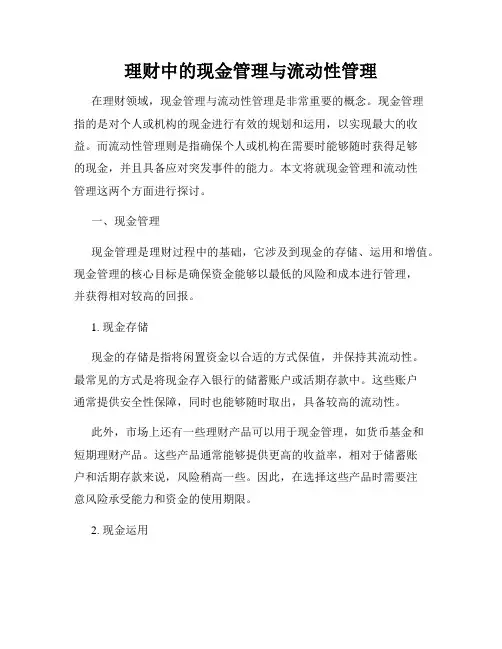
理财中的现金管理与流动性管理在理财领域,现金管理与流动性管理是非常重要的概念。
现金管理指的是对个人或机构的现金进行有效的规划和运用,以实现最大的收益。
而流动性管理则是指确保个人或机构在需要时能够随时获得足够的现金,并且具备应对突发事件的能力。
本文将就现金管理和流动性管理这两个方面进行探讨。
一、现金管理现金管理是理财过程中的基础,它涉及到现金的存储、运用和增值。
现金管理的核心目标是确保资金能够以最低的风险和成本进行管理,并获得相对较高的回报。
1. 现金存储现金的存储是指将闲置资金以合适的方式保值,并保持其流动性。
最常见的方式是将现金存入银行的储蓄账户或活期存款中。
这些账户通常提供安全性保障,同时也能够随时取出,具备较高的流动性。
此外,市场上还有一些理财产品可以用于现金管理,如货币基金和短期理财产品。
这些产品通常能够提供更高的收益率,相对于储蓄账户和活期存款来说,风险稍高一些。
因此,在选择这些产品时需要注意风险承受能力和资金的使用期限。
2. 现金运用现金管理不仅仅是将资金存储起来,更重要的是将资金运用起来获得回报。
在进行现金的运用时,需要综合考虑风险和收益,并选择适合的投资品种。
一种常见的运用方式是购买债券。
债券具有相对较低的风险和较为稳定的收益,在现金管理中扮演着重要的角色。
此外,股票、基金、房地产等也可以作为现金运用的方式,但相应地风险也会更高。
在进行现金的运用时,需要了解和评估各种投资品种的风险水平,同时关注投资市场的变化,及时调整投资策略。
二、流动性管理流动性管理是指个人或机构确保在需要时能够迅速获得足够现金的能力。
流动性管理旨在避免由于资金紧缺而导致无法满足支付或投资需求的情况发生,同时也能应对突发事件。
1. 现金预留为了应对紧急情况和未来的支付需求,现金预留是非常必要的。
通常,建议保持一定比例的现金作为预留资金,这样可以确保个人或机构能够应对突发事件。
2. 现金流量管理现金流量管理是指通过掌握支出和收入的情况,进行日常资金安排和管理。

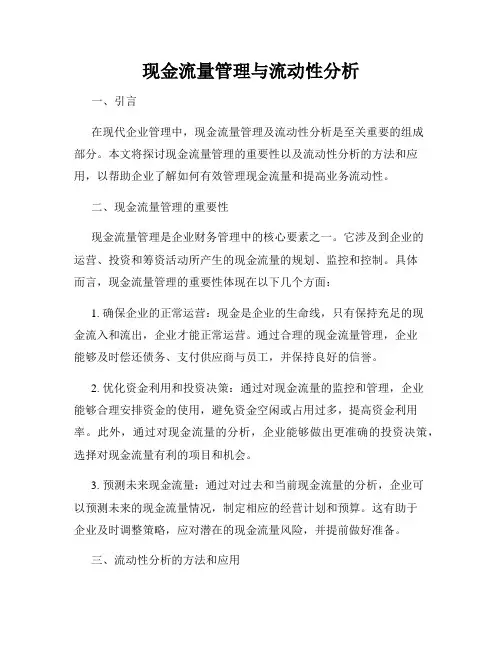
现金流量管理与流动性分析一、引言在现代企业管理中,现金流量管理及流动性分析是至关重要的组成部分。
本文将探讨现金流量管理的重要性以及流动性分析的方法和应用,以帮助企业了解如何有效管理现金流量和提高业务流动性。
二、现金流量管理的重要性现金流量管理是企业财务管理中的核心要素之一。
它涉及到企业的运营、投资和筹资活动所产生的现金流量的规划、监控和控制。
具体而言,现金流量管理的重要性体现在以下几个方面:1. 确保企业的正常运营:现金是企业的生命线,只有保持充足的现金流入和流出,企业才能正常运营。
通过合理的现金流量管理,企业能够及时偿还债务、支付供应商与员工,并保持良好的信誉。
2. 优化资金利用和投资决策:通过对现金流量的监控和管理,企业能够合理安排资金的使用,避免资金空闲或占用过多,提高资金利用率。
此外,通过对现金流量的分析,企业能够做出更准确的投资决策,选择对现金流量有利的项目和机会。
3. 预测未来现金流量:通过对过去和当前现金流量的分析,企业可以预测未来的现金流量情况,制定相应的经营计划和预算。
这有助于企业及时调整策略,应对潜在的现金流量风险,并提前做好准备。
三、流动性分析的方法和应用流动性分析是衡量企业偿付能力的重要工具。
通过对企业流动性的评估,可以了解企业偿债能力和运营能力,并及时采取相应措施。
下面介绍几种常用的流动性分析方法和应用:1. 流动比率(Current Ratio):流动比率是指企业流动资产与流动负债之间的比例关系。
它反映了企业的偿债能力和可支付责任能力。
流动比率越高,说明企业越具备偿付能力。
2. 速动比率(Quick Ratio):速动比率是指企业除去存货后的流动资产与流动负债之间的比例关系。
存货通常比较难以迅速变现,速动比率能够更加准确地评估企业的偿债能力。
3. 现金比率(Cash Ratio):现金比率是指企业现金与流动负债之间的比例关系。
它反映了企业在没有其他流动性资产的情况下,能够偿付多少流动负债。
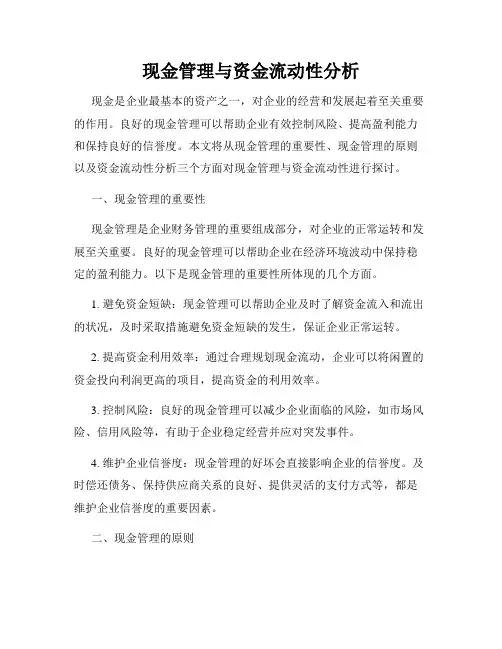
现金管理与资金流动性分析现金是企业最基本的资产之一,对企业的经营和发展起着至关重要的作用。
良好的现金管理可以帮助企业有效控制风险、提高盈利能力和保持良好的信誉度。
本文将从现金管理的重要性、现金管理的原则以及资金流动性分析三个方面对现金管理与资金流动性进行探讨。
一、现金管理的重要性现金管理是企业财务管理的重要组成部分,对企业的正常运转和发展至关重要。
良好的现金管理可以帮助企业在经济环境波动中保持稳定的盈利能力。
以下是现金管理的重要性所体现的几个方面。
1. 避免资金短缺:现金管理可以帮助企业及时了解资金流入和流出的状况,及时采取措施避免资金短缺的发生,保证企业正常运转。
2. 提高资金利用效率:通过合理规划现金流动,企业可以将闲置的资金投向利润更高的项目,提高资金的利用效率。
3. 控制风险:良好的现金管理可以减少企业面临的风险,如市场风险、信用风险等,有助于企业稳定经营并应对突发事件。
4. 维护企业信誉度:现金管理的好坏会直接影响企业的信誉度。
及时偿还债务、保持供应商关系的良好、提供灵活的支付方式等,都是维护企业信誉度的重要因素。
二、现金管理的原则良好的现金管理需要遵循一定的原则,以确保现金的充分利用和持续流动。
1. 现金的及时性原则:即企业应该尽量保持足够的现金储备,以应对突发事件或经营不稳定带来的风险。
同时,企业也要确保现金的流动性,及时回收应收账款并支付应付账款,避免资金的滞留。
2. 风险的控制原则:在现金管理中,企业需要权衡风险与利润之间的关系,合理控制风险水平。
例如,对于交易合作对象信用不足的情况,可以要求提前付款或选择其他合作伙伴,以减少风险。
3. 盈利的最大化原则:企业现金管理的目标是提高盈利能力,因此在决策中需要综合考虑现金流和盈利的关系。
企业应致力于降低现金成本,增加现金收入,以实现盈利最大化。
4. 灵活性原则:现金管理需要具备一定的灵活性,以应对市场变化。
企业应根据市场需求和自身情况,灵活调整现金管理策略,保持现金的充裕和流动。
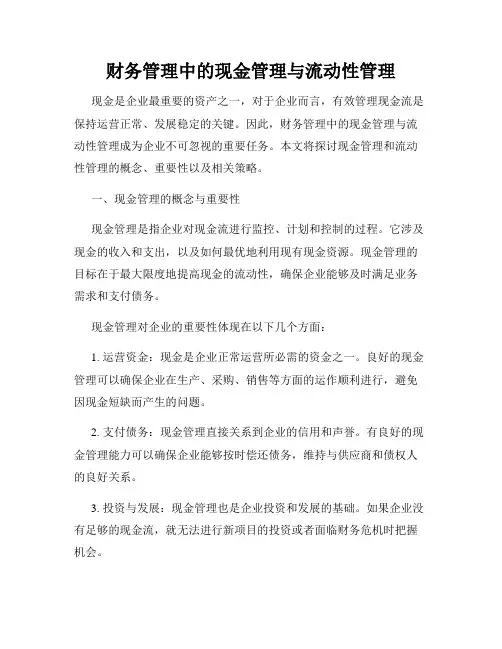
财务管理中的现金管理与流动性管理现金是企业最重要的资产之一,对于企业而言,有效管理现金流是保持运营正常、发展稳定的关键。
因此,财务管理中的现金管理与流动性管理成为企业不可忽视的重要任务。
本文将探讨现金管理和流动性管理的概念、重要性以及相关策略。
一、现金管理的概念与重要性现金管理是指企业对现金流进行监控、计划和控制的过程。
它涉及现金的收入和支出,以及如何最优地利用现有现金资源。
现金管理的目标在于最大限度地提高现金的流动性,确保企业能够及时满足业务需求和支付债务。
现金管理对企业的重要性体现在以下几个方面:1. 运营资金:现金是企业正常运营所必需的资金之一。
良好的现金管理可以确保企业在生产、采购、销售等方面的运作顺利进行,避免因现金短缺而产生的问题。
2. 支付债务:现金管理直接关系到企业的信用和声誉。
有良好的现金管理能力可以确保企业能够按时偿还债务,维持与供应商和债权人的良好关系。
3. 投资与发展:现金管理也是企业投资和发展的基础。
如果企业没有足够的现金流,就无法进行新项目的投资或者面临财务危机时把握机会。
二、现金管理的策略1. 预测与计划:企业应通过对市场需求和销售预测的分析,制定现金流预算和计划。
这样可以提前预知现金需求,并采取相应措施,以确保现金的充足性。
2. 现金流控制:企业应建立严格的审批和报销制度,控制现金的支出。
同时,应根据现金流预算和计划,及时收回应收账款,提高资金回收的效率。
3. 短期投资:企业可以将闲置的现金进行短期投资,以提高现金的回报率。
常见的短期投资工具包括货币市场基金、短期国债等。
这样可以增加企业的现金流和流动性。
4. 现金筹资:当企业出现短期现金流不足时,可以通过贷款、融资租赁等方式筹集临时性的现金流。
但需要注意风险控制,避免过度依赖债务。
三、流动性管理的概念与重要性流动性管理是指企业管理其短期债务和资产的能力,以确保企业能够满足短期债务偿付和经营活动的需要。
流动性管理的目标是实现合理的短期债务和流动资产的匹配,保持企业的偿债能力和运营的连续性。
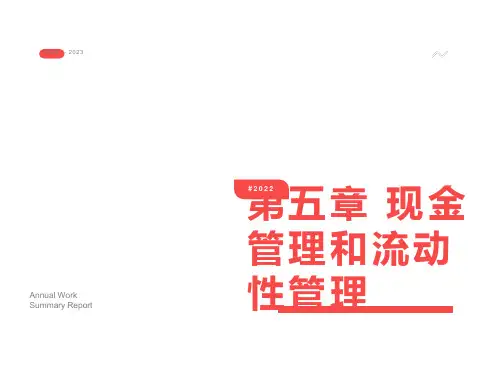
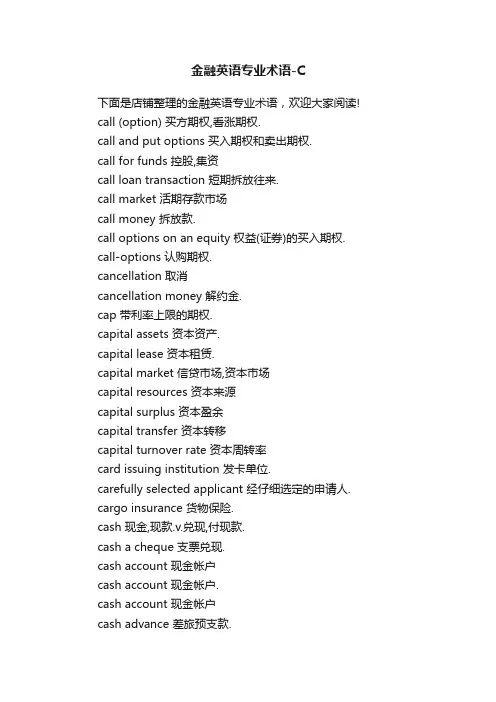
金融英语专业术语-C下面是店铺整理的金融英语专业术语,欢迎大家阅读! call (option) 买方期权,看涨期权.call and put options 买入期权和卖出期权.call for funds 控股,集资call loan transaction 短期拆放往来.call market 活期存款市场call money 拆放款.call options on an equity 权益(证券)的买入期权. call-options 认购期权.cancellation 取消cancellation money 解约金.cap 带利率上限的期权.capital assets 资本资产.capital lease 资本租赁.capital market 信贷市场,资本市场capital resources 资本来源capital surplus 资本盈余capital transfer 资本转移capital turnover rate 资本周转率card issuing institution 发卡单位.carefully selected applicant 经仔细选定的申请人. cargo insurance 货物保险.cash 现金,现款.v.兑现,付现款.cash a cheque 支票兑现.cash account 现金帐户cash account 现金帐户.cash account 现金帐户cash advance 差旅预支款.cash against bill of lading 凭提单付现.cash against documents(C.A.D.) 凭单付现,凭单据付现金=document against cash.cash and carry 付现自运;现金交易和运输自理;现购自运商店.cash and carry wholesale 付现自运批发.cash assets 现金资产.cash audit 现金审核cash audit 现金审核,现金审计.cash balance 现金余额,现款结存.cash basis 现金制cash basis 现金制,现金基础.cash basis accounting 现金收付会计制cash basis accounting 现金收付会计制.cash before delivery(C.B.D.) 空货前付款,付款后交货,付现款交货.cash bonus 现金红利.cash book 现金簿;现金帐;现金出纳帐.cash boy 送款员.cash budget 现金预算cash budget 现金预算.cash card1 (银行)自动提款卡.cash card2 现金卡.cash claim 现金索赔.cash collection basis 收现法,收现制.cash credit 活期信用放款,现金付出.cash credit slip 现金支出传票.cash currency 现金通货.cash cycle 现金循环,现金周期.cash day 付款日.cash debit slip 现金收入传票.cash department (商业机构中的)出纳部=counting-house.cash deposit 现金存款;保证金.cash deposit as collateral 保证金,押金.cash desk (商店,饭馆的)付款处.cash disbursements 现金支出.cash discount (c.d.) 现金折扣,付现折扣=settlement discount. cash dispenser (美)自动提款机=cashomat.cash dividend 现金股利cash down 即付,付现.cash equivalent value 现金等值,现金相等价值.cash flow 资金流动cash flow 现金流动.cash flow stream 现金流(量).cash holdings 库存现金cash holdings 库存现金.cash in advance (c.i.a.) 预付现金.cash in bank 存银行现金,银行存款.cash in hand (商行的)手头现金,库存现金=cash on hand. cash in transit 在途现金,在运现金.cash in transit policy 现金运送保险单.cash in treasury 库存现金.cash invoice 现购发票.cash items 现金帐项,现金科目.cash journal 现金日记簿.cash liquidity 现金流动(情况);现金周转.cash loan 现金贷款.cash management services 现金管理业务cash market 现金交易市场,现货市场,付现市场.cash nexus 现金交易关系.cash on arrival 货到付现,货到付款.cash on bank 银行存款;银行付款;现金支票付款.cash on deliver (C.O.D) (英)交货付款,现款交货=collect on delivery.cash on delivery (COD) 交割付款cash order(C/O) 现金订货.cash paid book 现金支出簿.cash payment 现金支付cash payment 现金付款,现付.cash payments journal 现金支出日记帐.cash position 头寸cash position 现金状况,现金头寸.cash price 现金售价,现金付款价格.cash purchase 现购,现金购买.cash railway (商店中的)货款传送线.cash ratio 现金比率.cash receipts (CR) 现金收入.cash receipts journal 现金收入日记帐.cash records 现金记录.cash register 现金登记机,现金收入记录机,收银机.cash remittance 汇款单;解款单.cash remittance note 现金解款单,解款单.cash requirement 现金需要量.cash reserve 现金储备(金).cash resources 现金资源,现金来源.cash resources (reserves) 现金准备cash sale 现售,现金销售=sale by real cash.cash sale invoice 现销发票,现售发票.cash settlement 现金结算,现汇结算.cash short and over 现金尾差,清点现金余差;现金短溢.cash slip 现金传票.cash statement 现金报表,(现金)库存表.cash ticket 现销票,门市发票.cash transaction 现金交易.cash verification 现金核实,现金核查.cash voucher 现金凭单;现金收据.cash with order (c.w.o., C.W.O.) 订货时付款,订货付现,落单付现.cash without discount 付现无折扣.cash yield discount 现金获利率,现金收益率.cash-and-carry arbitrage 现货持有套利.cashier 出纳员,收支员.cashier's cheque (C.C.) 银行本票=cashier's order.central rate 中心汇率(一国货币对美元的汇率,并据此计算对其他货币的汇率)certificate of balance 存款凭单Certificate of Deposits (CDs) 大额定期存款单certificated security 实物证券certificates of deposit (CDs) 大面额存款单certifying bank 付款保证银行change hands 交换,换手.chartered bank 特许银行chattel 动产.chattel mortgage 动产抵押.chattel mortgage 动产抵押.chattel mortgage bond (美)动产抵押(公司)债券.chattel personal (私人)动产.chattel real 准不动产(土地权等).check certificate 检验证明书.check deposit 支票存款check list (核对用的)清单.check sheet 对帐单.checking account 支票帐户.checking deposits 支票存款,活期存款checking reserve 支票现金储备.checkstand (超级市场的)点货收款台.cheque (payable) to bearer 来人支票,不记名支票. cheque book 支票簿.cheque book stub 支票簿存根.cheque card 支票卡.cheque collection 支票兑取.cheque collector 支票兑取人.cheque crossed 划线支票.cheque crossed generally 普通划线支票.cheque crossed specially 特别划线支票.cheque deposit 支票存款.cheque drawer 支票出票人.cheque holder 支票执票人.cheque only for account 转帐支票.cheque payable at sight 见票即付支票.cheque protector 支票银码机.cheque rate 票据汇兑汇率,票汇价格=sight rate ,short rate. cheque register 支票登记簿.cheque returned 退票,退回的支票.cheque signer 支票签名机.cheque stub 支票存根.cheque to order 记名支票,指定人支票.China Investment Bank 中国投资银行circulation risks 流通风险.circulation tax (turnover tax) 流转税.city bank 城市银行claim a refound 索赔.clean collections 光票托收clearing bank 清算银行clearing house 清算所.clearinghouse 清算公司,票据交换所.close out 平仓,结清(账).closed and mortgage 闭口抵押.closing order 收市价订单.closing rate 收盘价closing transaction 平仓交易collar 带利率上下限的期权.collateral loan 抵押借款.collecting bank 托收银行collecting bank 托收银行collecting bank 代收行collection instructions 委托(托收的)单据collection items 托收业务,托收项目collection of trade charges 托收货款collection on clean bill 光票托收collection on documents 跟单托收collection order 托收委托书collection risk 托收风险collection risks 托收风险.collection service 托收服务collective-owned enterprise bonus tax 集体企业奖金税. collective-owned enterprise income tax 集体企业所得税. commercial and industrial loans 工商贷款commercial deposit 商业存款commercial paper 商业票据commercial paper house 经营商业票据的商号commercial risk 商业风险.commercial terms 商业条件.commission 佣金commodity futures 商品期货. commodity insurance 商品保险. common collateral 共同担保.common fund 共同基金common stock 普通股common trust fund 共同信托基金compensatory financing 补偿性融资. competitive risks 竞争风险.composite depreciation 综合折旧. compound interest 复利compound rate 复利率compound rate deposit 复利存款comprehensive insurance 综合保险. condominium 公寓私有共有方式. confirming bank 保兑银行congestion area 震荡区congestion tape 统一自动行情显示conservatism and liquidity 稳健性与流动性consortium bank 银团银行constructure risk 建设风险.consumer financing 消费融资. contingent risks 或有风险.contract money 合同保证金.contract size 合约容量.contracts of difference 差异合约. contractual value 合同价格.controlled rates 控制的汇率converge 集聚,(为共同利益而)结合一起. conversion 汇兑,兑换convertible currency 可兑换的货币cooling-off period 等待期cooperative financing 合作金融.cornering the market 操纵市场corners 垄断.corporate deposits 法人存款correspondent 代理行cost of maintenance 维修费.counter-inflation policy 反通货膨胀对策counter-inflation policy 反通货膨胀对策counter-inflation policy 反通货膨胀对策cover 弥补,补进(卖完的商品等).cover 弥补(损失等);负担(开支);补进(商品或股票等);保险. coverage 承保险别;保险总额;范围保险.coverage ratio 偿债能力比率.cover-note 暂保单;投保通知单.credit 信用,信贷.credit account (C.A., C/A) 赊帐=open account2 credit agreement 信贷协定.credit amount 信贷金额;赊帐金额;信用证金额.credit analysis 信用分析.credit balance 贷方余额,结欠,贷余.credit bank 信贷银行credit beneficiary 信用证受益人.credit business 赊售,信用买卖.credit buying 赊购.credit capital 信贷资本.credit cards 信用卡credit control 信用控制credit control 信用控制credit control 信用控制credit control instrument 信用调节手段credit control instrument 信用调节手段credit control instrument 信用调节手段credit expansion 信用扩张credit expansion 信用扩张credit expansion 信用扩张credit extending policy 融资方针credit extending policy 融资方针credit extending policy 融资方针credit facility 信用透支.credit limit 信用额度.credit restriction 信用限额.credit risk 信用风险.credit union 信用合作社creditor bank 债权银行crop up (out) 出现,呈现.cross hedge 交叉套做.cross hedging 交叉保值.cum dividend 附息cum rights 含权cumulative preferred stock 累积优先股currency futures 外币期货.currency futures contract 货币期货合约. current fund 流动基金current futures price 现时的期货价格. current ratio 流动比率current ratio 流动比率current ratio 流动比率customize 按顾客的具体要求制作.customs duty(tariffs) 关税.。
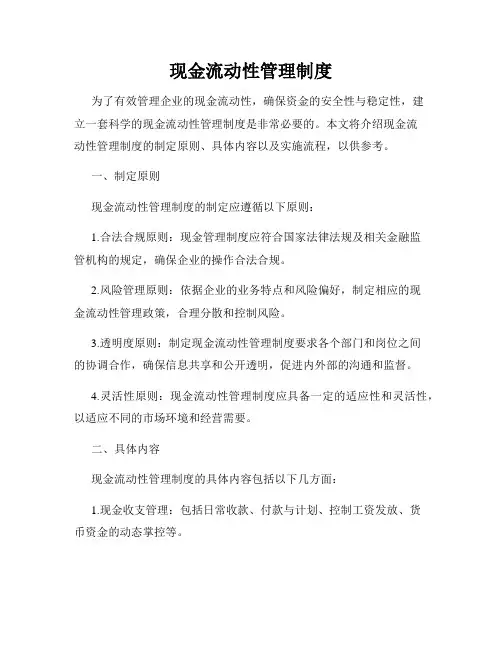
现金流动性管理制度为了有效管理企业的现金流动性,确保资金的安全性与稳定性,建立一套科学的现金流动性管理制度是非常必要的。
本文将介绍现金流动性管理制度的制定原则、具体内容以及实施流程,以供参考。
一、制定原则现金流动性管理制度的制定应遵循以下原则:1.合法合规原则:现金管理制度应符合国家法律法规及相关金融监管机构的规定,确保企业的操作合法合规。
2.风险管理原则:依据企业的业务特点和风险偏好,制定相应的现金流动性管理政策,合理分散和控制风险。
3.透明度原则:制定现金流动性管理制度要求各个部门和岗位之间的协调合作,确保信息共享和公开透明,促进内外部的沟通和监督。
4.灵活性原则:现金流动性管理制度应具备一定的适应性和灵活性,以适应不同的市场环境和经营需要。
二、具体内容现金流动性管理制度的具体内容包括以下几方面:1.现金收支管理:包括日常收款、付款与计划、控制工资发放、货币资金的动态掌控等。
2.资金调拨管理:根据企业的经营情况和资金需求,制定合理的资金调拨计划,确保资金的合理运作和投资。
3.现金预测与预警:通过财务报表和现金流量表的分析,制定现金预测和预警机制,及时发现和解决现金流动性问题。
4.短期借贷管理:建立短期借贷管理制度,包括资金来源、借贷规模、期限、利率等方面的规定,用于解决短期资金缺口。
5.投资理财管理:制定明确的投资理财策略,包括投资品种、投资期限、风险控制等,以实现较高的资金增值效果。
6.外汇管理:针对国际贸易和跨境业务,建立外汇管理制度,包括外汇收支的管控和风险防范。
7.内部控制与审计:建立健全的内部控制制度和现金流动性审计机制,确保现金管理的合规性和有效性。
三、实施流程现金流动性管理制度的实施流程应包括以下几个环节:1.制定制度:由企业的财务部门负责牵头,组织相关部门参与,制定现金流动性管理制度。
2.内部宣贯:通过内部会议、培训等形式,向企业内部全体员工宣传和推广现金流动性管理制度。
3.制定操作指南:制定详细的操作指南和相关流程,明确各岗位职责和操作要求。
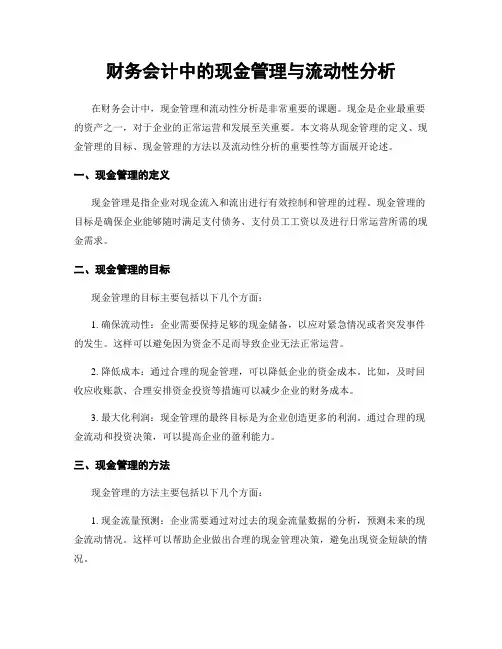
财务会计中的现金管理与流动性分析在财务会计中,现金管理和流动性分析是非常重要的课题。
现金是企业最重要的资产之一,对于企业的正常运营和发展至关重要。
本文将从现金管理的定义、现金管理的目标、现金管理的方法以及流动性分析的重要性等方面展开论述。
一、现金管理的定义现金管理是指企业对现金流入和流出进行有效控制和管理的过程。
现金管理的目标是确保企业能够随时满足支付债务、支付员工工资以及进行日常运营所需的现金需求。
二、现金管理的目标现金管理的目标主要包括以下几个方面:1. 确保流动性:企业需要保持足够的现金储备,以应对紧急情况或者突发事件的发生。
这样可以避免因为资金不足而导致企业无法正常运营。
2. 降低成本:通过合理的现金管理,可以降低企业的资金成本。
比如,及时回收应收账款、合理安排资金投资等措施可以减少企业的财务成本。
3. 最大化利润:现金管理的最终目标是为企业创造更多的利润。
通过合理的现金流动和投资决策,可以提高企业的盈利能力。
三、现金管理的方法现金管理的方法主要包括以下几个方面:1. 现金流量预测:企业需要通过对过去的现金流量数据的分析,预测未来的现金流动情况。
这样可以帮助企业做出合理的现金管理决策,避免出现资金短缺的情况。
2. 现金流量控制:企业需要建立有效的现金流量控制系统,确保现金的流入和流出得到有效的监控和控制。
这样可以避免现金的浪费和滥用,提高现金的使用效率。
3. 现金投资决策:企业需要根据自身的资金需求和风险承受能力,合理进行现金的投资。
比如,可以将闲置资金进行短期理财或者购买有收益的金融产品,提高资金的利用效率。
四、流动性分析的重要性流动性分析是对企业流动性状况的评估和分析。
流动性是企业偿付能力的重要指标,直接影响企业的生存和发展。
流动性分析可以帮助企业了解自身的现金流动情况,及时发现问题并采取相应的措施。
1. 风险管理:流动性分析可以帮助企业评估自身的偿债能力,及时发现资金短缺的风险。
通过合理的流动性管理,可以降低企业的财务风险,提高企业的抗风险能力。
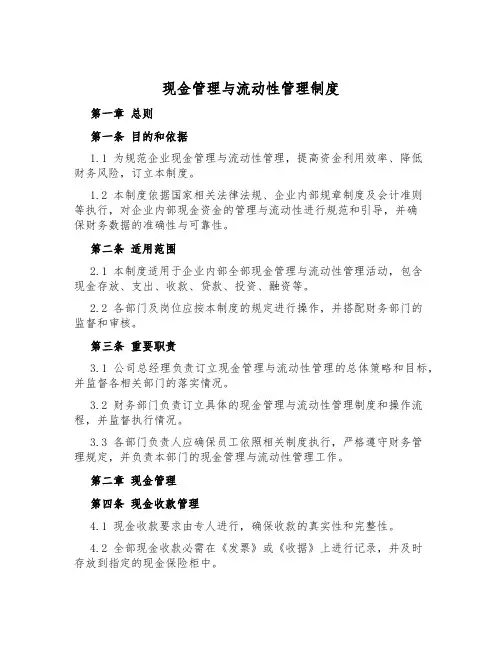
现金管理与流动性管理制度第一章总则第一条目的和依据1.1 为规范企业现金管理与流动性管理,提高资金利用效率、降低财务风险,订立本制度。
1.2 本制度依据国家相关法律法规、企业内部规章制度及会计准则等执行,对企业内部现金资金的管理与流动性进行规范和引导,并确保财务数据的准确性与可靠性。
第二条适用范围2.1 本制度适用于企业内部全部现金管理与流动性管理活动,包含现金存放、支出、收款、贷款、投资、融资等。
2.2 各部门及岗位应按本制度的规定进行操作,并搭配财务部门的监督和审核。
第三条重要职责3.1 公司总经理负责订立现金管理与流动性管理的总体策略和目标,并监督各相关部门的落实情况。
3.2 财务部门负责订立具体的现金管理与流动性管理制度和操作流程,并监督执行情况。
3.3 各部门负责人应确保员工依照相关制度执行,严格遵守财务管理规定,并负责本部门的现金管理与流动性管理工作。
第二章现金管理第四条现金收款管理4.1 现金收款要求由专人进行,确保收款的真实性和完整性。
4.2 全部现金收款必需在《发票》或《收据》上进行记录,并及时存放到指定的现金保险柜中。
第五条现金支出管理5.1 全部现金支出必需经过审批程序,而且只能由负有权限的人员操作。
5.2 每笔现金支出必需有相关凭证,并在支出后及时记录。
5.3 对于较大金额的现金支出,应采取多人审批制度,确保支出的准确性和合规性。
第六条现金存放管理6.1 现金必需存放在指定的现金保险柜中,保险柜必需定期检查并保持完好。
6.2 现金存放必需定期进行封存,确保现金的安全性和完整性。
6.3 禁止将现金存放在员工个人办公区域或其他不安全的地方。
第七条现金盘点管理7.1 每月末,对现金进行盘点,确保现金存量与账面记录全都。
7.2 盘点结果必需有独立的人员进行核对,并签署盘点报告。
7.3 盘点报告必需及时提交财务部门进行审核,并将审核结果记录。
第八条涉现金员工管理8.1 涉现金操作的员工必需经过严格的背景审查和培训,确保员工的诚信和专业性。
Content1.Introduction2.Definition2.1Liquidity2.2Cash FlowStatement of cash flow3.Liquidity management4.Cash Flow management5.Cash Accounting and Liquidity Planning6.Case Scenario:7.Conclusions1.Introduction"Cash is king." "Happiness is a positive cash flow." Where does money come from and where does it go?Liquidity is one of the critical success factors for a company; it is integral to running a business. The most important aspects of liquidity are the ability to ensure solvency and generate payment surpluses. Companies constantly try to analyze and plan their cash flow.Surveys are conducted constantly of failed businesses. Most failed businesses, up to 60%, say that all or most of their failure was due to cash flow problems. Businesses have to have as their guide another old saying. Nothing matters more than cash. Making a profit is nice, cash flow is necessary. Cash management is the key to business success.Start-up businesses often find themselves short of cash right off the mark. Existing businesses can find ways to survive if they can find ways to generate cash. Cash is the single most important element of survival for a small business. Small businesses often say that an inability to control cash is their single biggest problem. Unfortunately, established applications such as Accounting or Cash Management don’t provide the necessary information on cash flow required by companies;2.Definition2.1LiquidityYou often hear the word liquidity used in combination with cash management.Liquidity is the ability to fund assets and meet obligations as they come due.Liquidity is the amount an association holds in cash and other assets that are quickly convertible into cash without significant loss.Liquidity is an association’s capacity to meet its financial obligations and commitments at reasonable or acceptable costs.The essence of liquidity is having cash when you need it.In other words, if the firm has adequate liquidity, it can pay its current liabilities such as accounts payable. Usually, accounts payable are debts you owe your suppliers. There are methods you can use to measure your liquidity.Financial ratio analysis will help you determine how liquid your firm is or how successful it will be in meeting its short-term debt obligations. The current ratio will help you determine the ratio of your current assets to your current liabilities.Current assets include cash, accounts receivable, inventory, and occasionally other line items such as marketable securities. You need to have more current assets than current liabilities on your balance sheet at all times.The quick ratio will allow you to determine if you can pay your short-term debt obligations, or current liabilities, without having to sell any inventory. It's important for a firm to be able to do this because, if you sell have to sell inventory to pay billsthat means you have to find a buyer for that inventory. Finding a buyer is not always easy or possible.There is various other measure of liquidity that you will want to use to determine your cash position.2.2Cash FlowCash flow is the movement of cash into or out of a business, project, or financial product. (Note that "cash" is used here in the broader sense of the term, where it includes bank deposits.) It is usually measured during a specified, finite period of time. Measurement of cash flow can be used for calculating other parameters that give information on the companies' value and situation. Cash flow can e.g. be used for calculating parameters:To determine a project's rate of return or value. The time of cash flows into and out of projects are used as inputs in financial models such as internal rate of return, and net present value.To determine problems with a business's liquidity. Being profitable does not necessarily mean being liquid. A company can fail because of a shortage of cash, even while profitable.As an alternate measure of a business's profits when it is believed that accrual accounting concepts do not represent economic realities. For example, a company may be notionally profitable but generating little operational cash (as may be the case for a company that barters its products rather than selling for cash). In such acase, the company may be deriving additional operating cash by issuing shares, or raising additional debt finance.Cash flow can be used to evaluate the 'quality' of Income generated by accrual accounting. When Net Income is composed of large non-cash items it is considered low quality.To evaluate the risks within a financial product, e.g. matching cash requirements, evaluating default risk, re-investment requirements, etc.Cash flow is a generic term used differently depending on the context. It may be defined by users for their own purposes. It can refer to actual past flows, or to projected future flows. It can refer to the total of all the flows involved or to only a subset of those flows. Subset terms include 'net cash flow', operating cash flow and free.Figure : Cash Inflow and Cash Outflow from a Company’s PerspectiveAccording to the Financial Accounting Standards Board (FASB), the major recipients of cash accounting information that is contained in a cash flow statement are the following groups:Investors, lenders, suppliers, employees―To investors, lenders, suppliers, and employees, a business enterprise is a source of cash in the form of dividends or interests …, repayment of borrowing, payment for goods or services, or salaries or wages. They invest cash, goods, or services … expect to obtain sufficient cash in return …‖Customers―To custome rs, a business enterprise is a source of goods or service, but only by obtaining sufficient cash to pay for the resources it uses—and to meet its other obligations—can the enterprise provide those goods or services.‖Management―To managers, the cash flow s of a business enterprise are a significant part of their management responsibilities, including their accountability to directors and owners.‖2.3 Statement of cash flow in a business's financialsThe (total) net cash flow of a company over a period (typically a quarter or a full year) is equal to the change in cash balance over this period: positive if the cash balance increases (more cash becomes available), negative if the cash balance decreases. The total net cash flow is the sum of cash flows that are classified in three areas:1.Operational cash flows:Cash received or expended as a result of thecompany's internal business activities. It includes cash earnings plus changes to working capital. Over the medium term this must be net positive if the company is to remain solvent.+ Incoming payments from customers– Outgoing payments to suppliers= Cash flow from operating activities2.Investment cash flows:Cash received from the sale of long-life assets, orspent on capital expenditure (investments, acquisitions and long-life assets).+ Incoming payments from asset retirements–Outgoing payments for asset acquisitions+ Incoming payments from financial asset retirements–Outgoing payments for investments in financial assets= Cash flow from investing activities3.Financing cash flows:Cash received from the issue of debt and equity, orpaid out as dividends, share repurchases or debt repayments.+ Incoming payments from equity allocations–Outgoing payments to company shareholders+ Incoming payments from borrowings–Outgoing payments for loans= Cash flow from financing activitiesWays Companies Can Augment Reported Cash FlowSales - Sell the receivables to a factor for instant cash. (leading)Inventory - Don't pay your suppliers for an additional few weeks at period end.(lagging)Sales Commissions - Management can form a separate (but unrelated) company and act as its agent. The book of business can then be purchased quarterly as an investment.Wages - Remunerate with stock options.Maintenance - Contract with the predecessor company that you prepay five years worth for them to continue doing the workEquipment Leases - Buy itRent - Buy the property (sale and lease back, for example).Oil Exploration costs - Replace reserves by buying another company's.Research & Development - Wait for the product to be proven by a start-up lab;then buy the lab.Consulting Fees - Pay in shares from treasury since usually to related partiesInterest - Issue convertible debt where the conversion rate changes with the unpaid interest.Taxes - Buy shelf companies with TaxLossCarryForward's. Or gussy up the purchase by buying a lab or O&G explore co. with the same TLCF.Example:The net cash flow only provides a limited amount of information. Compare, for example, the cash flows over three years of two companies:Company A Company BYear 1 Year 2 year 3 Year 1 Year 2 year 3 Cash flow from operations +20M +21M +22M +10M +11M +12M Cash flow from financing +5M +5M +5M +5M +5M +5M Cash flow from investment -15M -15M -15M 0M 0M 0M Net cash flow +10M +11M +12M +15M +16M +17MCompany B has a higher yearly cash flow. However, Company A is actually earning more cash by its core activities and has already spent 45M in long term investments, of which the revenues will only show up after three years.3.Liquidity managementManaging liquidity is a fundamental component in the safe and sound management of all financial institutions. Sound liquidity management involves prudently managing assets and liabilities (on- and off-balance sheet), both as to cash flow and concentration, to ensure that cash inflows have an appropriate relationship to approaching cash outflows. This needs to be supported by a process of liquidity planning which assesses potential future liquidity needs, taking into account changes in economic, regulatory or other operating conditions. Such planning involves identifying known, expected and potential cash outflows and weighing alternative asset/liability management strategies to ensure that adequate cash inflows will be available to the institution to meet these needs.The objectives of liquidity management are:Honoring all cash outflow commitments (both on- and off-balance sheet) on an ongoing, daily basis;Avoiding raising funds at market premiums or through the forced sale of assets;andSatisfying statutory liquidity and statutory reserve requirements.Although the particulars of liquidity management will differ among institutions depending upon the nature and complexity of their operations and risk profile, a comprehensive liquidity management program requires:Establishing and implementing sound and prudent liquidity and funding policies;andDeveloping and implementing effective techniques and procedures to monitor measure and control the institution’s liquidity requirements and position.4.Cash Flow managementThe bottom line to good cash management is that, in a crisis, typical financial statements become irrelevant and all that is important is surviving from a cash point of view. In a cash crisis, such as a recession, a business owner's focus becomes, by necessity, very short-term. Often, a cash crisis will instill good cash management practices into business managers that carry over from that day forward. Managers have to understand how to prepare a monthly cash budget. Next, they must understand sources and uses of cash like are stated on the Statement of Cash Flows, one of three required financial statements. The feedback you get from these financial statements is invaluable. Starting with inventory and accounts receivable, if managers can maximize their cash flow, they can almost always avoid running out of operating cash and exposing themselves to cash flow problems.How to Maximize Your Cash FlowYour goal, as the owner and manager of your company, is to squeeze all the cash out of your balance sheet that you can. Not only do you want to get as much cash out of your company as you can, you want to keep it out in case of a potential or actual crisis.Two of your current asset accounts are usually big drains on your cash. They are inventory and accounts receivable. Inventory is the products you sell and accountsreceivable are your credit accounts or those the accounts that represent the credit you extend to customers. The balances in both accounts need to be converted to cash as soon as possible.You can use financial ratio analysis to check out your position regarding inventory and accounts receivables. Inventory turnover ratios can tell you if your inventory is obsolete or if you are selling so fast you are stocking out. Accounts receivable ratios, such as day’s sales outstanding, can tell you how fast your credit customers are cleaning up their accounts among other things. Once you determine the position of your inventory and receivables, you can take the appropriate actions to adjust the situations and have more cash coming in to your firm.Another way to get more cash into your business regarding your credit customers and accounts receivables is using a lockbox system to collect payments. If you have payments wired or mailed to a lockbox, those payments get into your account faster. Your bank can then sweep funds into interest-bearing accounts.Another short-term strategy to squeeze money out of your balance sheet is to look at the current liabilities on your balance sheet. Focus on your accounts payable. They are what you owe your suppliers. Pay your accounts payable on the day they are due, not early. There is no reason to give your suppliers the use of your cash days before the bill is due. Your business needs to have use of that cash. Stretch out the use of your funds.5.Cash Accounting and Liquidity PlanningIn busin ess literature, you’ll find countless discussions about the concept of cash accounting and its definition. In these discussions, you’ll also encounter the following Terms: cash budget management, flow-of-funds analysis, and cash flow statement, as well as cash flow accounting.Cash accounting records the changes of cash flows, cash flows being incoming and outgoing payments of liquid funds such as cash in hand and bank savings.In accordance with national and international accounting standards such as FASB and IAS, we will use the term“cash flow‖ to describe the changes in the means of payment. Liquidity is therefore referred to as a financial accounting-related concept. Within a certain period, cash accounting records transactions that have a direct influence on the stock of liquid funds, regardless of the period the payments refer to. In addition, it is now apparent that in business theory, cash accounting always refers to several periods. The Liquidity Planner component consists of two applications, the first application, Actual Calculation, refers to past and current periods, while the other application future periods.6.Case Scenario:Implementing Cash Accounting and Liquidity Planning Based on a specific real-life situation that we’ve encountered several times, we will build up a scenario for implementing SAP Liquidity Planner. This example is used to support your understanding of the functionality and the technical concept of SAP Liquidity Planner, but it will also serve as an aide in helping you to implement this component. The initial situation looks as follows: We’ll consider an international corporation, the IDES Group, which is structured as follows:The corporate headquarters is in Germany. The central departments of corporate accounting and global treasury are also located in Germany.Legally independent production sites exist in Germany and Eastern Europe.The sales and distribution network stretches across Europe and the US, with legally independent sales companies in the respective countries.Research and development is located at corporate headquarters in Germany.IDES uses SAP as its standard business software with the currently implemented applications:SAP FI for accountingSAP CO for controllingSAP SD for sales and distributionSAP MM for materials managementSAP PP for production7.ConclusionsJust like an individual or a family, companies need cash cushion to rely on. This gives them security in unstable times. It also gives them an opportunity to take advantage of strategic investments or take advantage of opportunities to reduce costs. Small businesses also have to focus on the concept of free cash flow in order to establish that cash cushion.When your business is just starting up, you essentially run it out of a check book, which is an example of cash accounting. As long as there is cash in the account, your business is solvent. As your business becomes more complex, you will have to adopt financial accounting. However, you have to keep a focus on liquidity and cash management even though you track net income through financial accounting. Focusing on liquidity comes more naturally to a CEO than to an accountant who is trained to practice accrual accounting.One of the first things that successful businesses did during the recession was to look at their borrowing and renegotiate the terms to something that, while it may be over more years and ultimately more expensive, has lower payments now. Yes, adding more debt is probably a bad idea for most businesses, but if refinancing existing debt allows you to stay in business, there's a definite upside to doing it.In a word, the making money flow inside, there were a few tricksReference:Books:Financial management and real options Jack BroylesModern financial management Ross, westerfield, Jaffe Financial Management An introduction Jim Mcuenamin Websites:/od/cashmanagement/a/cash_mngt.htm /wiki/Cash_flow/publications/review/F09-4-Liquidity.asp。
现金管理与流动性管理技巧现金是企业运行中至关重要的资源,它直接影响着企业的生存与发展。
因此,有效的现金管理和流动性管理对企业来说至关重要。
本文将介绍现金管理和流动性管理的意义,并分享一些实用的技巧来帮助企业更好地管理现金和保持流动性。
一、现金管理的意义现金管理是指对企业现金流进出和使用的全过程进行有效监控和管理,以实现现金的最优化配置。
它的意义主要体现在以下几个方面:1.保证企业的正常运营:充足的现金储备可以确保企业在面对突发情况或经济困难时能够维持正常的运营,如支付员工工资、购买原材料等。
2.提高资金利用效率:通过合理规划现金流动,企业可以最大限度地减少闲置资金并有效利用其余现金,如进行投资、还贷、支付供应商等,提高利润和财务回报。
3.降低企业运营风险:现金管理的规范化操作可以帮助企业降低资金风险,避免资金的浪费、挪用和损失,确保财务的安全和稳定。
二、现金管理技巧1.预测现金流:通过合理的财务分析和预测方法,企业可以准确估计未来一段时间内的现金流动情况,为现金管理做出相应的决策,防范风险。
2.制定预算:制定合理的预算计划,包括资金支出和收入的规划,以确保企业的现金流动与支出保持平衡,合理安排资金的使用。
3.优化资金周转:通过积极主动地管理企业的账款和供应链,优化企业的资金周转周期,控制现金流的进出,提高资金使用效率。
4.提高收款效率:加强对客户的信用管理,催促客户及时支付款项,可以大幅度提高企业的现金流入速度,减少呆账风险。
5.降低成本:优化企业的支付策略,如与供应商洽谈延长付款期限,并选择适当的资金来源和融资方式,以降低企业的资金成本。
三、流动性管理技巧流动性管理是指企业对其短期资金需求和偿债能力进行合理规划和管理的过程。
以下是一些流动性管理的技巧:1.做好现金流量表:企业应该建立和维护准确的现金流量表,包括日常生活费、应付账款、应收账款等,以及其他现金流量的来源和去向。
通过对现金流量的监控,可以确保企业的流动性得到有效管理。
现金管理和流动性风险管理现金管理是指企业对于自身现金流的有效管理,包括收款、付款、投资等各方面,以保证企业的流动性和正常经营。
流动性风险则是指企业可能遇到的难以变现、流动性不足的情况,如果不加以管理,则可能导致企业经营失衡、甚至破产。
因此,对于企业来说,现金管理和流动性风险管理是非常重要的,下面分别进行探讨。
一、现金管理1. 现金收付管理企业要做好现金收付管理,首先要建立一个完整的现金流管理体系,包括现金的来源、去向、结构等方面。
同时,建立严密的财务制度和内部控制制度,对于现金的收付过程进行规范和监督。
要加强财务人员的管理和培训,确保他们了解公司的财务状况和现金流情况,并严格执行财务制度和内部控制制度。
要加强与银行之间的联系,及时了解自己的账户余额和交易记录,以保证及时掌握公司的投资和资金调度等情况。
2. 现金投资管理现金的投资是企业的一项重要工作,要做好现金投资管理,必须结合企业的经营特点和风险偏好,根据自己的具体情况来选择适合自己的投资方案。
一般来说,企业可以选择低风险、流动性强的投资品种,如银行定期存款、货币基金、短期国债等。
同时,还要注意分散投资风险,综合考虑投资回报率和流动性等因素,制定合理的投资策略。
3. 现金税务管理在现金管理中,税务管理是非常重要的一环,因为税款的缴纳和申报对于企业的现金流和财务状况有着直接影响。
要把税费管理放在现金管理的重要位置,加强对税务政策和法规的学习,规范税务处理程序,及时申报缴纳税款,以免被罚款或影响到企业的经营和发展。
二、流动性风险管理流动性风险管理是指企业对于自身流动性风险的有效管理,包括流动性指标的监测、应急储备资金的配置、流动性风险的评估等方面。
流动性风险管理的核心在于预判,既要预测未来经济形势和市场环境的变化,又要预判企业自身可能面临的流动性风险。
1. 流动性指标的监测企业要做好流动性风险管理,首先要对企业的流动性指标进行监测,及时掌握企业的流动性问题。
现金管理与流动性风险管理现金是企业中最重要的资产之一,对于企业的运营和发展至关重要。
同时,流动性风险也是企业面临的一个重要挑战。
本文将探讨现金管理与流动性风险管理的重要性,并介绍一些相关策略和方法。
一、现金管理的重要性现金管理是指企业对现金资金进行有效和高效的利用、支配和控制的过程。
现金对于企业的正常运转至关重要,它不仅涉及到企业的日常经营活动,还关系到企业的短期和长期发展。
一个良好的现金管理系统可以帮助企业实现以下几个方面的目标:1. 确保流动性:有效的现金管理可以确保企业有足够的流动性,以应对可能出现的资金短缺或紧急情况。
这是保持企业正常运营的关键。
2. 优化利润:透明的现金管理系统可以帮助企业识别和利用投资和融资机会,从而增加投资收益和减少利息支出。
3. 控制风险:现金管理可以帮助企业监控和控制各种风险,包括市场风险、信用风险和流动性风险等。
通过及时的现金流分析和风险评估,企业可以降低经营风险,并采取相应的应对措施。
二、流动性风险管理的重要性流动性风险是指企业无法按时偿还到期债务或资金不足以支付日常运营费用的风险。
流动性风险可能导致企业无法正常开展业务,甚至引发破产。
因此,合理管理流动性风险对于企业的生存和发展至关重要。
1. 流动性风险的挑战:企业面临的流动性风险可能来源于多个方面,包括资金流入的不确定性、资金流出的不稳定性和外部环境的不确定性等。
2. 流动性风险管理策略:a. 预测和规划现金流:企业应该对预期的现金流入和流出进行准确预测,并制定相应的现金管理计划。
这可以帮助企业及时识别潜在的流动性问题,并采取相应的预防措施。
b. 多元化融资渠道:企业可以通过多元化融资渠道来降低流动性风险。
除了传统的银行贷款,企业还可以考虑发行债券、吸引投资者等方式来获取资金。
c. 紧急资金储备:企业可以建立紧急资金储备,用于应对可能出现的紧急情况。
这可以在企业面临流动性压力时提供及时的资金支持。
三、现金管理与流动性风险管理的实施步骤为了有效地管理现金和流动性风险,企业可以采取以下步骤:1. 分析现金流:企业应该对现金流的来源和用途进行详细的分析,并制定相应的流动性计划和预测。
处理应付账款和付款管理小额现金处理应收账款和收款催款管理现金打开图例业务场景描述本业务场景包含以下业务角色:现金和流动性管理业务场景使中型企业的财务人员可以快速、有效地按时限管理现金流,提高公司流动性状况管理的透明度。
其中包含应付账款、应收账款和税务现金流以及付款和流动性管理信息,通过自动收集和汇总这些信息简化您的日常现金管理循环。
此业务场景涵盖从实际流动性快照、预测和分析步骤到资金转移或其他现金流影响策略的优化现金流管理循环。
请点击流程的燕尾图了解详细信息采购到支付业务场景(库存/非库存/服务)费用和报销管理财务结账客户退货现场服务和维修从订单到收款业务场景(按库存销售/标准化服务/基于项目的服务)客户退货ScenarioExplorer业务场景/流程业务价值业务场景流+其他信息打开图例业务场景描述本业务场景包含以下业务角色:现金和流动性管理业务场景使中型企业的财务人员可以快速、有效地按时限管理现金流,提高公司流动性状况管理的透明度。
其中包含应付账款、应收账款和税务现金流以及付款和流动性管理信息,通过自动收集和汇总这些信息简化您的日常现金管理循环。
此业务场景涵盖从实际流动性快照、预测和分析步骤到资金转移或其他现金流影响策略的优化现金流管理循环。
请点击流程的燕尾图了解详细信息图例主要由用户执行的流程主要由系统执行的流程系统不支持的手动流程与第三方软件通信的流程(鼠标悬停了解更多信息)与财务相关的流程相关业务场景关闭图例处理应付账款和付款管理小额现金处理应收账款和收款催款管理现金ScenarioExplorer采购到支付业务场景(库存/非库存/服务)费用和报销管理财务结账客户退货现场服务和维修从订单到收款业务场景(按库存销售/标准化服务/基于项目的服务)客户退货业务场景/流程业务价值业务场景流+其他信息主要流程的集中燕尾图请点击流程的燕尾图了解详细信息处理应付账款和付款处理对账单分配款项清算款项请点击此处显示流程变式XScenario Explorer流程描述处理应付账款和付款业务流程用于处理付款,不论付款从贵公司内部发起还是供应商从外部发起。
可以手动发起付款,也可通过付款运行自动发起付款,系统在付款运行中建议未清付款项。
然后,您下达款项,系统将其过账到会计流程。
您手动创建付款媒介或通过自动运行创建。
标准工作中心提供支票、银行转账付款、贷记凭证及其他国家特定付款方式。
款项从银行账户中扣账后,以电子上传或手动输入方式在系统中输入银行对账单,然后进行确认。
如果付款由外部发起,银行对账单将提供已付款的通知。
系统在清算前将付款与未清发票进行匹配。
其他信息执行者应付账款会计相关工作中心应付账款付款管理流动性管理i i i管理小额现金处理应收账款和收款催款管理现金另请参见付款分配快速向导手动分配付款业务场景/流程业务价值业务场景流+其他信息请点击流程的燕尾图了解详细信息处理应付账款和付款业务流程用于处理付款,不论付款从贵公司内部发起还是供应商从外部发起。
可以手动发起付款,也可通过付款运行自动发起付款,系统在付款运行中建议未清付款项。
然后,您下达款项,系统将其过账到会计流程。
您手动创建付款媒介或通过自动运行创建。
标准工作中心提供支票、银行转账付款、贷记凭证及其他国家特定付款方式。
款项从银行账户中扣账后,以电子上传或手动输入方式在系统中输入银行对账单,然后进行确认。
如果付款由外部发起,银行对账单将提供已付款的通知。
系统在清算前将付款与未清发票进行匹配。
自动处理付款手动处理汇票付款在未清项目清算中手动处理付款处理小额现金付款i i i iScenario Explorer流程描述其他信息主要流程的集中燕尾图处理应付账款和付款处理对账单分配款项清算款项请点击此处隐藏流程变式Xii i管理小额现金处理应收账款和收款催款管理现金执行者应付账款会计相关工作中心应付账款付款管理流动性管理业务场景/流程业务价值业务场景流+其他信息另请参见付款分配快速向导手动分配付款流程详细信息:管理小额现金Scenario Explorer请点击流程的燕尾图了解详细信息管理小额现金X创建现金收入或支出流程描述管理小额现金业务流程使贵公司可以在系统中输入所有现金收款和付款。
小额现金需要始终含充足现金用于现金付款。
因此,可在银行账户和小额现金之间或者在小额现金资金之间转移现金。
i其他信息处理应收账款和收款催款管理现金处理应付账款和付款执行者应付账款会计相关工作中心付款管理业务场景/流程业务价值业务场景流+其他信息另请参见付款分配快速向导手动分配付款Scenario Explorer请点击流程的燕尾图了解详细信息处理应收账款和收款输入汇款通知书处理银行对账单分配款项清算款项请点击此处显示流程变式流程描述处理应收账款和收款业务流程用于处理收款,不论付款从贵公司内部发起还是从客户外部发起。
此流程使用国家特定的收款方式。
可以手动发起或通过付款运行自动发起付款,系统在付款运行中建议未清付款项目。
然后,您下达款项,系统将其过账到会计流程。
您可以使用直接扣账文件或信用卡付账的收款文件手动创建付款媒介,或将其作为自动运行的一部分进行创建。
也可以上传信用卡对账单预确认款项。
款项贷记到公司银行账户后,将银行对账单以电子方式上传到系统或手动输入系统,然后确认。
如果由客户在外部发起付款,则银行对账单将提供收款通知。
系统在清算前将款项与未清发票相匹配。
ii i iX其他信息处理应付账款和付款管理小额现金催款管理现金相关工作中心应收账款付款管理流动性管理执行者应收账款会计另请参见付款分配和清算业务场景/流程业务价值业务场景流+其他信息流程描述处理应收账款和收款业务流程用于处理收款,不论付款从贵公司内部发起还是从客户外部发起。
此流程使用国家特定的收款方式。
可以手动发起或通过付款运行自动发起付款,系统在付款运行中建议未清付款项目。
然后,您下达款项,系统将其过账到会计流程。
您可以使用直接扣账文件或信用卡付账的收款文件手动创建付款媒介,或将其作为自动运行的一部分进行创建。
也可以上传信用卡对账单预确认款项。
款项贷记到公司银行账户后,将银行对账单以电子方式上传到系统或手动输入系统,然后确认。
如果由客户在外部发起付款,则银行对账单将提供收款通知。
系统在清算前将款项与未清发票相匹配。
处理外部发起的支票收款处理外部发起的支票箱支票收款处理外部发起的多张支票收款处理汇票收款处理小额现金收款处理内部发起的信用卡付账收款处理内部发起的直接扣账收款Scenario Explorer请点击流程的燕尾图了解详细信息i i i i i i i其他信息处理应收账款和收款输入汇款通知书处理银行对账单分配款项清算款项请点击此处隐藏流程变式ii i iX处理应付账款和付款管理小额现金催款管理现金相关工作中心应收账款付款管理流动性管理执行者应收账款会计另请参见付款分配快速向导内部发起的手动付款业务场景/流程业务价值业务场景流+其他信息催款流程详细信息:催款Scenario Explorer创建催款建议处理催款建议下达催款建议Xi i i请点击流程的燕尾图了解详细信息流程描述催款业务流程包括自动创建催款建议。
贵公司可以编辑和下达催款建议,以向客户发送逾期付款的付款提醒或催款通知。
其他信息处理应付账款和付款管理小额现金处理应收账款和收款管理现金相关工作中心应收账款付款管理流动性管理执行者应收账款会计另请参见创建催款运行催款运行快速向导业务场景/流程业务价值业务场景流+其他信息管理现金流程详细信息:管理现金Scenario Explorer显示和分析现金头寸创建流动性状态创建计划项目i i i 请点击流程的燕尾图了解详细信息创建现金转账处理银行对账单分配款项i i i流程描述管理现金业务流程使您可以查看所有付款流程的状态,以分析贵公司的现金余额并实时确定现金头寸。
此业务流程准备相关信息,并根据预计的结算日期创建作为流动性预测处理的计划项目。
如有必要,贵公司可在银行账户之间转移资金。
也可以在您集团内不同公司的银行账户之间转移资金。
…X其他信息管理小额现金处理应收账款和收款催款执行者应付账款会计相关工作中心付款管理流动性管理另请参见监控付款分配处理付款监控快速向导业务场景/流程业务价值业务场景流+其他信息收集收集银行余额交易明细检索现金收入ScenarioExplorer检索现金支出管理转移资金投资/借款优化现金流时间线合并设置现金头寸设置流动性预测分析分析当日现金余额分析未来现金余额概览此业务场景使中型企业的财务人员可以快速、有效地按时限管理现金流,提高公司流动性状况管理的透明度,从而简化日常现金管理循环。
为您提供有效、快速、简便地自动收集和汇总流动性信息的途径。
SAP Business ByDesign有助于高效管理流动性管理:从实际流动性快照、预测和分析步骤到资金转移或其他现金流影响策略的优化现金流。
主要优点●“现金和流动性管理”为有效的财务价值链管理提供了分析框架,其中包含用于银行余额报告、流动性监控和优化流动性状况的工具。
●现金经理可以轻松地确定、发起和执行所需的资金转移以管理投资多余现金或筹措短缺资金等流动性状态。
●使用自动流程收集来自银行的账户余额和交易信息,以及公司内不同业务单位现金收入、支出和其他财务活动等内部信息。
●内置分析和报告可确保流动性信息无缝集成到当日现金头寸和各种预测工作簿中。
分析工具支持全面的流动性分析、预计各种报告条件和时间线的现金短缺或盈余。
业务价值业务价值业务场景/流程业务场景流+其他信息图例和变式业务场景变式:Scenario Explorer小额现金•自动付款•在未清项目清算中手工付款•使用小额现金付款•….处理应付账款和付款费用和报销管理采购到支付业务场景(库存/非库存/服务)财务结账从订单到收款(供应商直接发货)客户退货管理现金付款管理应付账款付款管理现金和流动性业务场景/流程Scenario Flow 业务场景流业务价值+其他信息业务场景变式:Scenario Explorer•内部发起的直接扣账收款•外部发起的支票收款•外部发起的银行转账收款•内部发起的直接扣账收款•账户维护-标准变式现场服务和维修从订单到收款业务场景(按库存销售/标准化服务/基于项目的服务/供应商直接发货)客户退货管理现金催款小额现金付款管理应收账款现金和流动性图例和变式处理应付账款和付款付款管理应付账款业务场景/流程Scenario Flow 业务场景流业务价值+其他信息其他信息ScenarioExplorer业务价值业务场景/流程+业务场景流论坛与专家联系,讨论您的具体需求。
要进入社区,请点击此处。
*更多详细信息SAP 提供完整的产品文档,介绍了业务场景的各个方面。